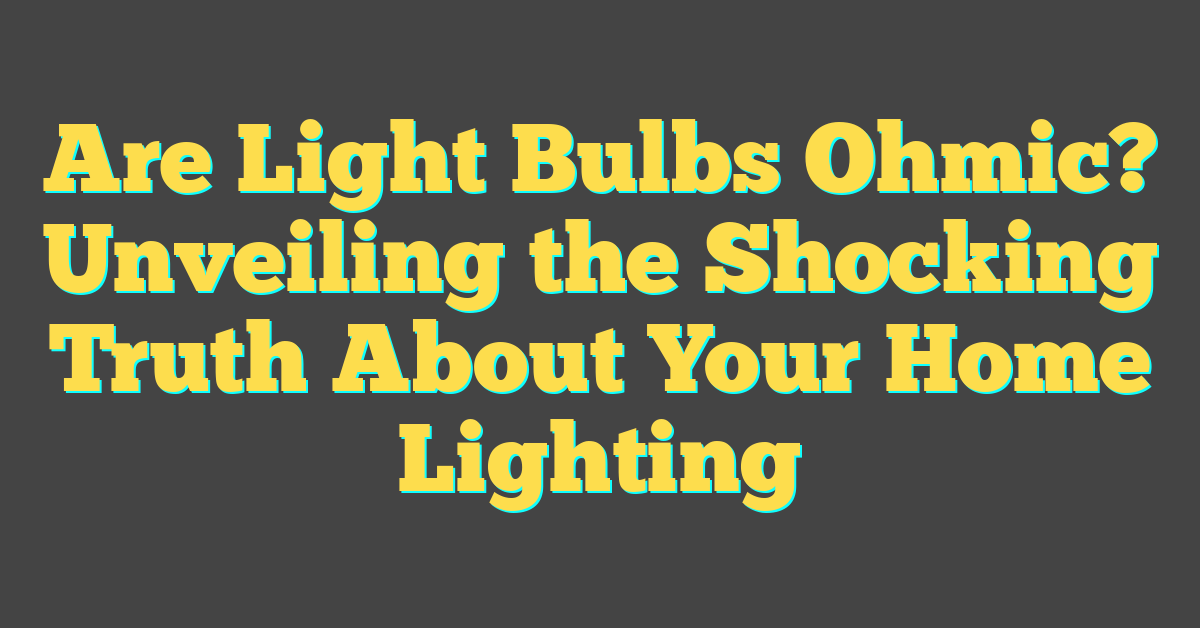Ever wondered why the glow from a light bulb often bathes your room in a warm, yellowish hue? It’s not just about ambiance; there’s science behind it. You might be surprised to learn that the color of light a bulb emits is no random choice.

From the cozy feel of a living room to the focused beam over your reading nook, the yellowish light has its reasons for being the go-to color. It’s all about the temperature of the light and the material of the filament inside the bulb. Let’s shed some light on this illuminating topic.
The Influence of Temperature on Light Color
Have you ever noticed how some light bulbs cast a cozy, amber glow while others shine bright white? The secret behind this illuminating color play is the temperature of the light—scientifically known as color temperature, measured in Kelvins (K).
In the realm of home lighting, understanding color temperature is key to creating your desired ambiance. The typical incandescent bulb, which many associate with a warm, inviting atmosphere, typically has a color temperature around 2,700K, making it emit that familiar yellowish hue. On the flip side, bulbs labeled as “daylight” can reach temperatures up to 6,500K and display a much whiter or even bluish light.
- Below 3,000K: Warm White
- Cozy, calm, and inviting
- Between 3,000K and 4,500K: Cool White
- Clear, crisp, ideal for task lighting
- Above 4,500K: Daylight
- Energetic and vibrant
The filament within your bulb is the game-changer. As electric current runs through it, it heats up, and its temperature determines the color of light emitted. A lower temperature results in a light with more red and yellow tones—hence the coziness of a warm bulb. As the temperature increases, the light begins to take on a bluer quality.
Here’s a quick reference:
| Color Temperature (K) | Light Appearance |
|---|---|
| < 3,000 | Warm White |
| 3,000 – 4,500 | Cool White |
| > 4,500 | Daylight |
As a lighting enthusiast and DIYer, you know that the right color temperature can redefine a space. It’s about more than brightness; it’s about the feeling you want to evoke in your room. The soft glow of lower-temperature bulbs is just right for unwinding after a long day, while higher-temperature bulbs are your go-to for detail-oriented tasks or when you’re looking for that midday burst of sunshine inside your home.
The Role of Filament Material in Light Color

Ever wonder why the light bulb glows with a particular hue? The answer’s not just in the temperature; it’s also what’s inside that counts. The filament material is the heart of a light bulb, and it’s what gives your cozy room that warm, inviting glow or your study its bright, focus-enhancing shine.
Filaments are mostly made from tungsten due to its high melting point, making it ideal for withstanding the intense heat necessary to produce light. When electricity passes through the filament, it heats up to temperatures that make it white-hot, literally, and that’s when it starts emitting photons—you know, light.
Tungsten filaments in incandescent bulbs emit a spectrum of light that’s rich in red and yellow hues, giving you that classic yellow glow. But that’s not your only option. Halogen bulbs also use tungsten filaments, but they’re encased in a quartz envelope filled with a halogen gas, which allows them to burn hotter and produce a more “white” light compared to standard incandescents.
If you’re a fan of DIY projects or lighting upgrades, you’ve likely encountered the term “Color Rendering Index” or CRI. This index, measured on a scale from 0 to 100, indicates how accurate colors appear under a light source compared to natural daylight. Tungsten filaments have a high CRI, which means they’re fantastic for showing colors in their truest form—a must when you’re perfecting the ambiance in a space.
But let’s not forget about LEDs, which have brought a revolution to the bulb market. Instead of a filament, LEDs use a semiconductor that emits light when current passes through it. They produce light that spans a broad color temperature range and can mimic the yellow glow of incandescent without the heat.
Here’s the gist: the filament material isn’t just a tiny coil of metal; it’s what determines if your light will be as golden as the sun or as bright as midday. And whether you’re curling up with a book or getting down to business, the right kind of light makes all the difference. So next time you’re picking out bulbs for your next home project, take a moment to consider the filament and how it’ll shape the light in your life.
The Kelvin Scale and Color Temperature

« How Much Does Fluorescent Light Bulbs Produce? Unlocking Lumens & Efficiency
How Do Light Bulbs Die? 7 Tips to Keep Them Glowing Longer »
When you’re selecting the perfect light bulb for your home DIY project or simply to brighten up your space, you’ll often come across terms like “warm white” or “cool white.” What do these descriptors actually refer to? They’re all about color temperature, measured in Kelvins (K) on the Kelvin scale.
This scale represents the appearance of light emitted by a black body radiator – a theoretical object that absorbs all incident radiation and reflects none. As the black body heats up, it changes color in a predictable manner: from red to orange to yellow, white, and then blue. The Kelvin scale captures this color progression as the object’s temperature increases.
Lights with a lower Kelvin value, around 2700K to 3000K, impart a warm, yellowish glow similar to that of a traditional incandescent bulb. This warmth makes these lights an excellent choice for living rooms or bedrooms where you want to create a cozy, inviting atmosphere.
On the other hand, bulbs with a Kelvin value between 5000K and 6500K produce a cooler, more “daylight” or “blue” feel. This kind of light is often used in settings where attention to detail is paramount, such as in an office or a kitchen. It’s where tasks require you to see everything clearly, without the warm color bias that may affect your perception.
Here is a quick reference of color temperature ranges:
| Color Temperature | Description |
|---|---|
| 2700K – 3000K | Warm White |
| 3100K – 4500K | Cool White |
| 5000K – 6500K | Daylight or Cool Blue |
Remember, the Kelvin scale doesn’t only help you understand the color temperature. It also assists in determining how your room “feels.” A higher Kelvin count means you’re veering into the territory where the light mimics the noonday sun, which can energize you and may even help with concentration and alertness. Meanwhile, lower Kelvin lights, resembling the warm hues of sunrise or sunset, contribute to relaxation and winding down.
Keep in mind, however, that color temperature is just one piece of the puzzle when choosing the right light bulb. You’ll also want to consider the aforementioned CRI, especially if rendering colors as they would appear in natural light is critical for your room or project.
The Connection Between Light Color and Ambiance

As a home DIY enthusiast and a lighting expert, you’re no stranger to the subtle, yet profound impact that light color has on ambiance. Natural sunlight is ever-changing, shifting from the warm, golden hues of dawn to the stark brightness of midday, then easing into the soft, reddish glow of twilight. Artificial lighting, however, gives you the control to mimic these effects to achieve your desired atmosphere.
Think about those cozy evenings spent at home. That comfortable, inviting ambiance is usually bathed in a warm, yellowish light. The reason for this is deeply rooted in psychological responses. Yellow light mimics the warmth of the sun at sunrise or sunset, creating a relaxing and calming environment. This is why restaurants often use bulbs with lower Kelvin values to create an intimate dining experience.
On the flip side, settings like home offices and classrooms benefit from cooler light. Bulbs with higher Kelvin values promote concentration and emulate the crisp clarity of daylight. You’ll find that these cooler tones make details stand out and colors pop, making them ideal for task-oriented areas.
Moreover, the color of light doesn’t only affect visual comfort but can also influence body rhythms and sleep cycles. Exposure to yellow light, especially in the evenings, helps to signal the body that it’s time to wind down. This is important in maintaining a healthy circadian rhythm, contrary to blue light, which can disrupt sleep patterns.
When it comes to choosing the right bulb for your next home project or DIY makeover, consider the functional aspect of the room and the type of ambiance you want to imbue. A well-thought-out selection can enhance the aesthetics of your space, improve functionality, and positively affect well-being. Keep in mind the specific tasks that will be performed in the space, and let the ideal color temperature serve as your guide in creating the perfect setting.
The Impact of Light Color on Visibility and Eye Strain

When you’re tackling your next home DIY project, lighting should be at the top of your list, not just for aesthetics but for functionality too. Ever noticed how yellow lightbulbs tend to be easier on your eyes? That’s because light color temperature plays a significant role in how we perceive visual clarity and how much strain our eyes undergo.
Warmer light, typically yellowish, like the sun at dawn or dusk, provides a relaxing atmosphere. It’s why your living room feels more welcoming when you switch on that lamp with the golden glow. But it’s not just about comfort—this hue can reduce eye strain, especially in low-light conditions. Your eyes don’t have to work as hard, making that all-nighter with your latest page-turner more enjoyable.
In contrast, cooler light has its place in settings where detail and alertness are key. Imagine you’re in your workshop, painting fine lines on a model or threading a needle—the bluish-white light from a daylight bulb makes those minute details pop. It mimics natural daylight, promoting concentration and sharpness. But beware, these cooler temperatures can increase eye strain over time, so it’s crucial to balance periods of work with enough rest for your eyes.
Let’s drop some science into the mix. A study from the Lighting Research Center found that a light’s color temperature affects visual comfort and acuity. Here’s a quick glance:
| Color Temperature (Kelvin) | Environment | Visibility |
|---|---|---|
| 2700K-3000K | Residential/Relaxing areas | Enhanced, Reduced Eye Strain |
| 3500K-4100K | Workspaces/Offices | Adequate for Tasks, Moderate Eye Strain |
| 5000K-6500K | Areas requiring high focus | High Visual Acuity, Possible Increased Strain |
Eye strain is a serious business—symptoms like headaches, blurred vision, and dry eyes shouldn’t be taken lightly. When choosing bulbs for your home projects or workspace, remember, it’s not just about wattage or energy efficiency—color temperature matters. Pick the light that suits your task and comfort level best, and your eyes will thank you.
Conclusion
You’ve seen how the color of your light bulb can make a big difference in your comfort and productivity. Remember, yellowish light isn’t just for ambiance; it’s a practical choice for your eyes in low-light settings. Next time you’re picking out bulbs, think about the tasks you’ll be doing in each room. Whether it’s reading a book in a cozy nook or poring over paperwork in your home office, choosing the right color temperature can help keep your eyes relaxed and focused. So go ahead and light your space wisely—it’s a bright idea that your eyes will thank you for!
Frequently Asked Questions
What impact does light color have on visibility and eye strain?
Warmer light colors, such as yellowish hues, tend to create a relaxing atmosphere and are more comfortable for the eyes in low-light conditions, reducing eye strain. Cooler light colors, like bluish-white, improve visibility for tasks requiring alertness and attention to detail but can cause more eye strain if used excessively.
Is yellow or blue light better for reducing eye strain?
Yellow light is better for reducing eye strain, especially in low-light conditions. It promotes a comforting and relaxing environment, making it ideal for winding down and reducing stress on the eyes.
What is the best light color for concentration and detail-oriented tasks?
Bluish-white light is best for concentration and tasks that require a high level of detail. It helps maintain alertness and enhances visual acuity, making it suitable for environments like offices or study spaces.
How does color temperature affect eye comfort?
Different color temperatures have varied effects on eye comfort. Warmer color temperatures (lower Kelvin ratings) are typically more comforting to the eyes, while cooler temperatures (higher Kelvin ratings) can increase visual acuity but may lead to more discomfort over time.
Should I consider color temperature when choosing light bulbs?
Yes, considering color temperature when selecting light bulbs is important to ensure they match the intended use of the space. Warmer temperatures are better for relaxing areas, while cooler temperatures are preferable for work and reading areas to prevent eye strain and increase visibility.




